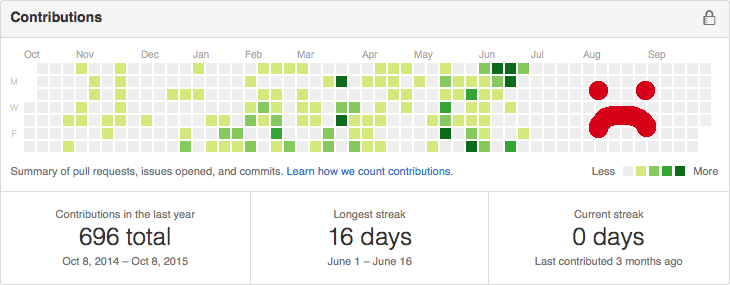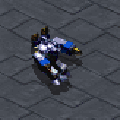Warning: this post is completely about myself. Writing helps me clear my thoughts.
Last year, I decided to put my new side projects on GitHub. One year later I had a nice present: 1000 commits!

It was a cool achievement because I didn’t try to game the system. Every single commit was meaningful and helped me become better at what I do.
Then I decided to drop my side projects and work overtime instead. A project at work could use it, and my side projects were just toy projects with no strings attached, so it seemed a good time to try it out.
When I say drop, I don’t mean it halfway. I didn’t push a single commit in 3 months.

But what about the effect on my work?
TL;DR not worth it. My output was higher during the first two months, but then I could feel burnout approaching. (I started a company a few years ago and failed; it left me with a mangled bank account but also with a keen sense of where my limits are.) I subconsciously protected myself from burnout by spending more time relaxing instead of working. By month four, my output was back to normal. The only difference was that I relaxed by going out or goofing off at home, instead of working on my side projects like before.
My happiness level also took a massive plunge. Months two and three were awful.
Lessons from this experiment:
- Side projects contribute a lot to my happiness. I started again yesterday and it feels great.
- Time spent on side projects does not contribute much towards my burnout limit.
- Overtime works—for a time. After one month my mental state starts to suffer. After three months my output is back to normal.
I love side projects because they’re all about building and learning. If you pick side projects that target areas you want to improve, 8 hours at work plus 1 hour on side projects is a much better learning strategy than 9 hours at work plus nothing else. (Replace “8 hours” by any amount that seems reasonable to you. Also, this might be untrue for special cases like founder or sole engineer in a tiny startup. The responsibilities there are so wide it’s like having a myriad of side projects that happen to be related.)
What you learn with your side projects will eventually make you bring more value in 8 hours than you would have in 9 hours otherwise. Everybody wins. This is especially true if you enjoy your work and intend to stay for many years.

This is old news to anyone who played or watched real-time strategy games such as StarCraft. You don’t want to spend 100% of your economy producing SCVs (the Terran worker in StarCraft). But, unless going for a timing push, you don’t want to completely stop producing SCVs either, or you will get crushed long-term. Your best strategy is to keep a steady production of SCVs going for almost the entire duration of the game.
Your side projects are your SCVs. Keep building them!
(This is a terrible analogy.)
And I should rather say “keep building them if you can”. It’s sometimes easy to forget that not everyone has the opportunity to spend free time on toy projects.